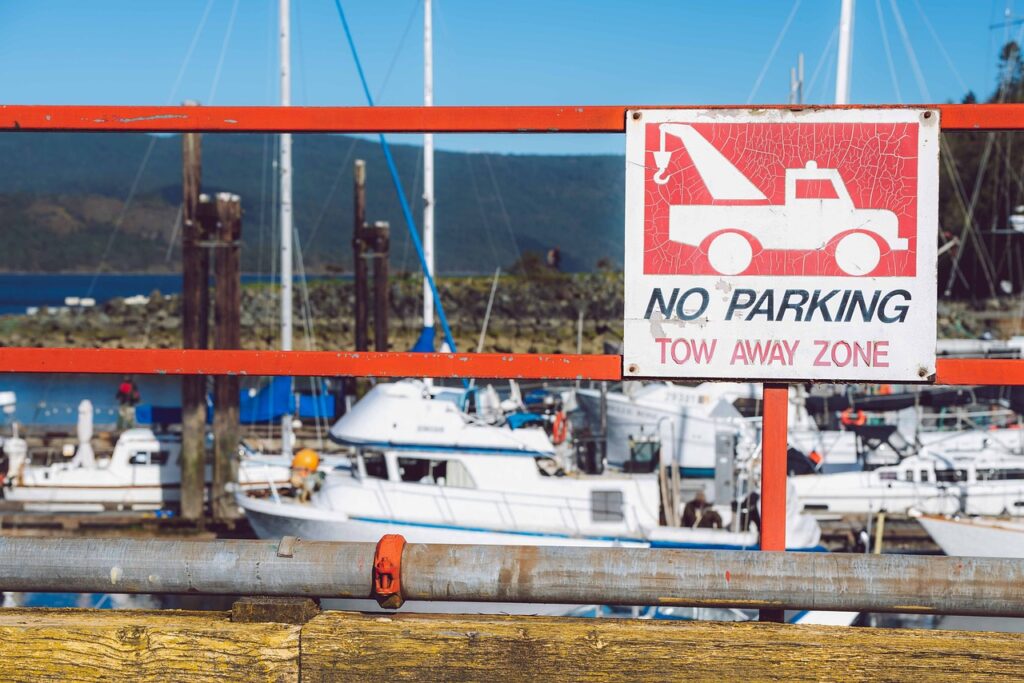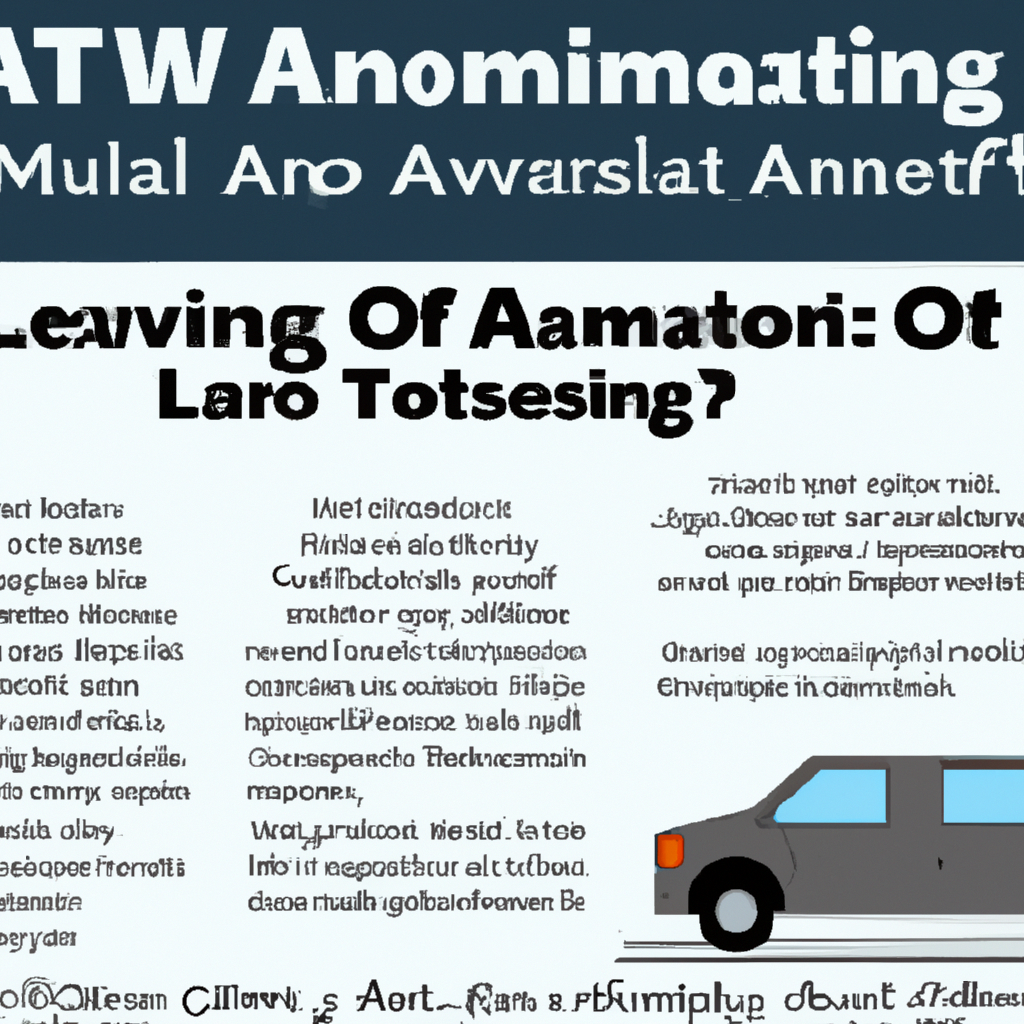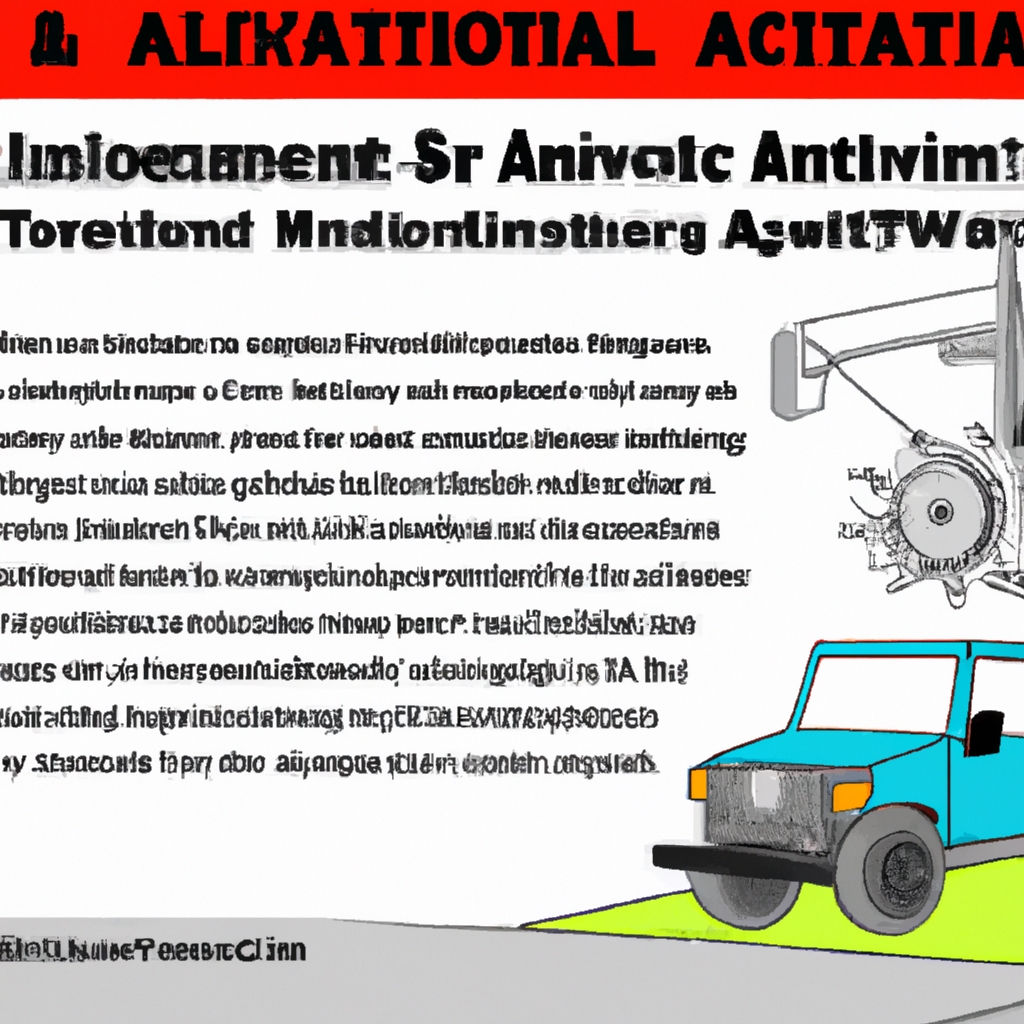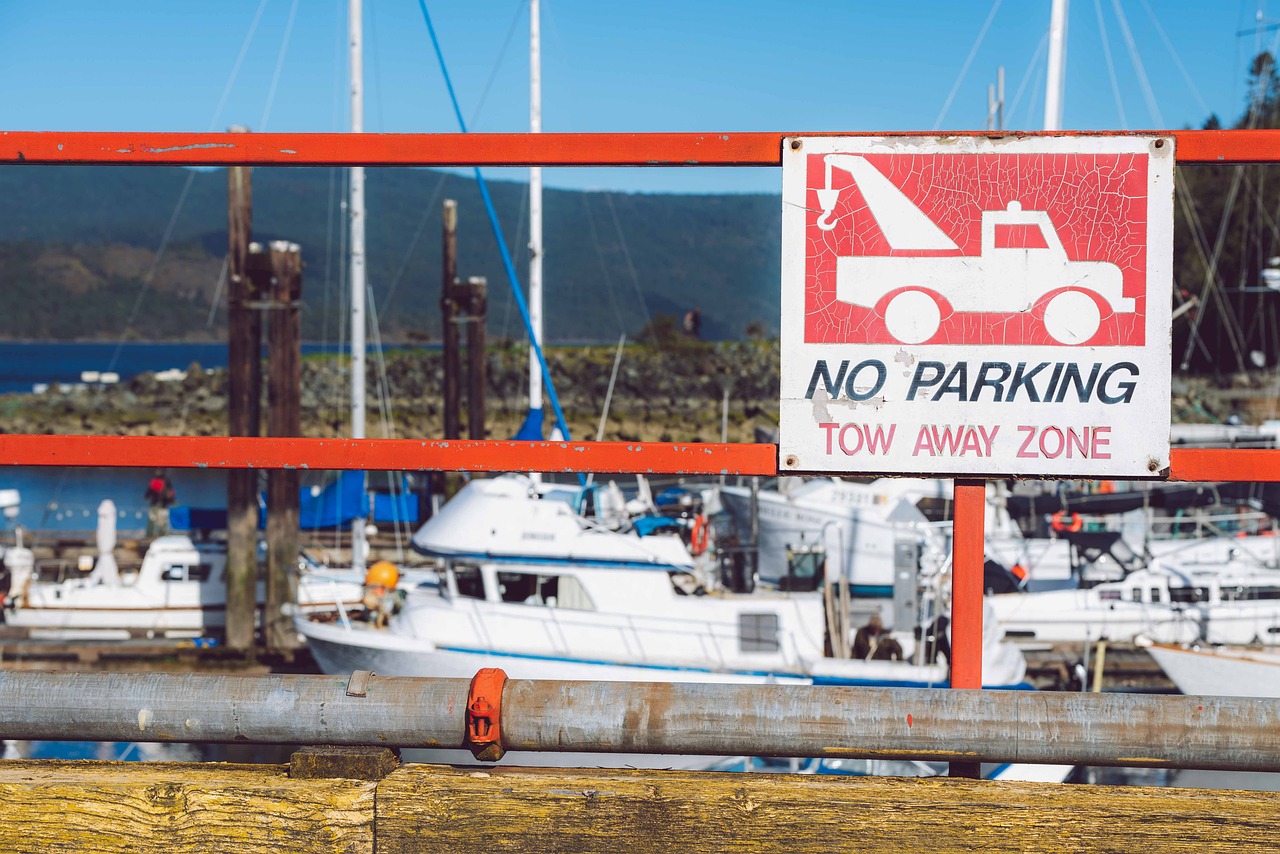The article, titled “Why Can You Not Tow An Automatic?” delves into the reasons why towing an automatic vehicle is not recommended. It explores the potential damages that can occur to an automatic transmission during the towing process and explains how the lack of lubrication can lead to severe internal damage. Additionally, this article provides insight into the differences between towing an automatic vehicle and a manual one, emphasizing the need for professional assistance to ensure the safety and integrity of both the vehicle and the transmission.
Understanding Automatic Transmissions
Automatic transmissions are a crucial component of modern vehicles, providing a convenient and efficient way to transfer power from the engine to the wheels. Understanding how automatic transmissions work and their various components is essential for any vehicle owner. Additionally, it is important to be aware of the advantages that automatic transmissions offer over their manual counterparts.
How Automatic Transmissions Work
Automatic transmissions utilize a complex system of gears, hydraulic fluid, and electronic controls to seamlessly shift gears without any input from the driver. The main components of an automatic transmission include the torque converter, planetary gearsets, clutches, and bands.
When the engine is running, the torque converter transfers power from the engine to the transmission. The transmission then uses a series of planetary gearsets to select the appropriate gear ratio based on the vehicle’s speed and the driver’s input. The clutches and bands within the transmission engage and disengage to control the power flow to the wheels.
Components of an Automatic Transmission
An automatic transmission consists of several key components that work together to ensure smooth and efficient operation. These components include the torque converter, planetary gearsets, clutches, bands, valve body, and transmission control module.
The torque converter is responsible for connecting the engine to the transmission and allows for the multiplication of torque. Planetary gearsets are used to select the appropriate gear ratio, while clutches and bands control the power flow within the transmission. The valve body directs the flow of hydraulic fluid to the various components of the transmission, and the transmission control module monitors and controls the operation of the transmission.
Advantages of Automatic Transmissions
Automatic transmissions offer several advantages over manual transmissions. One of the key advantages is the ease of use, as automatic transmissions do not require the driver to manually shift gears. This makes them particularly suitable for stop-and-go traffic, as the transmission can seamlessly shift gears without any input from the driver.
Automatic transmissions also provide better fuel efficiency in many cases. Their ability to shift gears at optimal points in the engine’s RPM range allows for greater efficiency. Additionally, automatic transmissions are generally more user-friendly and require less maintenance compared to manual transmissions.
Towing Considerations for Automatic Transmissions
While automatic transmissions are designed to handle the demands of everyday driving, special considerations must be taken when towing a vehicle with an automatic transmission. Towing can put additional stress on the transmission and its components, potentially leading to damage or failure if not done properly. Understanding the specific considerations for towing automatic vehicles is crucial to avoid costly repairs and ensure safety.
Fluid Circulation
Proper fluid circulation is essential for the operation and longevity of an automatic transmission, especially during towing. Towing places a significant strain on the transmission, increasing the risk of overheating. The transmission fluid not only serves as a lubricant but also helps in dissipating heat. Adequate fluid circulation is necessary to keep the transmission cool and prevent damage.
Transmission Pump Engagement
The transmission pump plays a vital role in maintaining the hydraulic pressure needed for proper gear engagement. During towing, the transmission pump may not engage effectively due to a lack of engine RPM. Insufficient pump engagement can lead to inadequate fluid pressure, resulting in gear slippage and potential transmission damage.
Heat Generation
Towing puts additional strain on the engine and transmission, leading to increased heat generation. Excessive heat can cause the transmission fluid to break down, reducing its effectiveness in lubricating and cooling the transmission. It is crucial to monitor the transmission temperature and take necessary precautions to prevent overheating, such as installing a transmission cooler.
Vehicle Weight Distribution
Proper weight distribution is crucial when towing an automatic vehicle to ensure stability and reduce strain on the transmission. Uneven weight distribution can put excessive load on the transmission, potentially leading to damage. It is important to follow the manufacturer’s recommendations regarding weight limits and ensure that the load is properly distributed across the vehicle and trailer.
Transmission Cooling
In addition to the transmission fluid, additional cooling mechanisms may be required when towing an automatic vehicle. This is especially important in situations where the transmission temperature can rise significantly, such as when towing heavy loads or driving in hilly terrain. Installing a transmission cooler can help dissipate the heat generated during towing and maintain optimal operating temperatures.
Engine Damage Risks
Towing an automatic vehicle improperly can also put the engine at risk of damage. The additional load from the towed vehicle can strain the engine, potentially leading to overheating, reduced performance, or even engine failure. It is essential to consider the vehicle’s towing capacity and ensure that the engine is capable of handling the added load.

This image is property of pixabay.com.
Potential Risks of Towing an Automatic Vehicle
Towing an automatic vehicle carries inherent risks that can adversely affect the transmission’s functionality and overall vehicle performance. It is crucial to be aware of these risks and take necessary precautions to minimize potential damage.
Transmission Damage
The transmission is designed to handle the demands of regular driving, but towing places additional strain on its components. The increased load from the towed vehicle can lead to excessive heat buildup, inadequate lubrication, and increased wear and tear. These factors can increase the risk of transmission damage, including clutch burnout, gear slippage, and fluid leaks.
Fluid Pump Failure
Insufficient engagement of the transmission pump during towing can result in low fluid pressure, leading to a range of transmission issues. Without proper fluid pressure, the clutches and bands may not engage properly, causing slipping gears and potential damage to the transmission. It is essential to ensure that the transmission pump engages effectively to maintain adequate fluid pressure.
Overheating
Towing places additional strain on the transmission, resulting in increased heat generation. If the transmission temperature exceeds safe operating levels, it can lead to fluid degradation, reduced lubrication, and accelerated wear. Overheating can also cause seals to deteriorate, leading to fluid leaks and potential transmission damage. Regular monitoring of the transmission temperature is essential to prevent overheating.
Slippage and Wear
Towing a vehicle can cause excessive stress on the transmission’s components, leading to clutch slippage and increased wear. The increased load from the towed vehicle can overwhelm the clutch pack, resulting in reduced power transfer and compromised performance. Over time, this can lead to decreased transmission efficiency and the need for costly repairs.
Torque Converter Issues
The torque converter is a crucial component of an automatic transmission, responsible for transferring power from the engine to the transmission. Towing can put strain on the torque converter, potentially leading to issues such as overheating, fluid foaming, and lockup clutch problems. Proper maintenance and monitoring of the torque converter are necessary to prevent potential damage.
Limitations of Towing Automatic Vehicles
Towing an automatic vehicle comes with certain limitations that must be considered to ensure safe and reliable towing. These limitations can vary depending on factors such as the manufacturer’s recommendations, the type of transmission, and the specific vehicle model.
Manufacturer Recommendations
Manufacturers provide specific guidelines and recommendations regarding towing with automatic transmissions. It is essential to consult the vehicle’s owner’s manual or contact the manufacturer to understand the towing capacity, recommended equipment, and any limitations or restrictions that may apply. Following these recommendations is crucial to avoid potential damage and warranty issues.
Towing Mode and Capacity
Many modern automatic vehicles are equipped with towing modes or settings that optimize the transmission’s performance during towing. Engaging the towing mode can adjust shift points, increase torque delivery, and provide improved stability. It is important to understand the capabilities and limitations of the towing mode for your specific vehicle. Additionally, exceeding the vehicle’s towing capacity can pose significant risks to the transmission and overall vehicle safety.
Four-Wheel Drive Vehicles
Towing four-wheel drive (4WD) vehicles can introduce additional considerations due to their unique drivetrain configuration. Some 4WD vehicles can be towed with all four wheels on the ground, while others may require special procedures, such as disconnecting the driveshaft or using a flatbed trailer. It is crucial to consult the owner’s manual or contact the manufacturer for specific instructions on towing 4WD vehicles.
Front-Wheel Drive Vehicles
Front-wheel drive (FWD) vehicles generally pose fewer challenges when it comes to towing. Most FWD vehicles can be towed with the front wheels off the ground or using a tow dolly. However, it is important to ensure that the transmission is in neutral and the parking brake is disengaged to prevent potential damage.
Rear-Wheel Drive Vehicles
Towing rear-wheel drive (RWD) vehicles also requires certain considerations. While some RWD vehicles can be towed with the rear wheels off the ground or using a tow dolly, others may require a flatbed trailer or specific towing procedures. It is crucial to consult the owner’s manual or contact the manufacturer for instructions on towing RWD vehicles.
Flat Towing vs Dolly Towing
When towing an automatic vehicle, the method used can impact the transmission and overall vehicle safety. Flat towing, also known as dinghy towing, involves towing the vehicle with all four wheels on the ground. This method can put additional strain on the transmission due to the lack of lubrication and cooling while the engine is not running. Dolly towing, on the other hand, involves towing the vehicle with two wheels off the ground using a tow dolly. This method can help protect the transmission by reducing the strain on its components.
Possible Exceptions with Specific Models
Some specific vehicle models may have unique towing considerations or exceptions. It is essential to consult the owner’s manual or contact the manufacturer for any model-specific instructions or limitations. These exceptions may involve additional precautions or specific towing procedures to ensure safe towing.
Aftermarket Modifications
It is important to note that certain aftermarket modifications can affect the towing capabilities and transmission functionality of automatic vehicles. Modifications such as lifting kits, towing packages, or engine modifications can alter the vehicle’s weight distribution, towing capacity, and overall drivetrain performance. It is crucial to consult with a qualified mechanic or the manufacturer before making any aftermarket modifications that may impact towing.

Alternatives to Towing an Automatic Vehicle
In situations where towing an automatic vehicle may not be practical or advisable, considering alternative transportation options can help ensure safe and efficient vehicle relocation.
Professional Towing Services
Professional towing services specialize in safely and effectively towing vehicles, including those with automatic transmissions. Towing professionals have the expertise and specialized equipment to properly secure and transport vehicles, reducing the risks associated with towing. Utilizing professional towing services can provide peace of mind and ensure the safety of the vehicle and its transmission.
Transportation Trailers
Using a transportation trailer, such as a car hauler or enclosed trailer, can provide a safe and reliable alternative to towing an automatic vehicle. Transportation trailers allow the entire vehicle to be lifted off the ground, eliminating the strain on the transmission components. This method is particularly useful for long-distance transportation or when towing multiple vehicles.
Flatbed Trucks
Flatbed trucks are another option for safely transporting automatic vehicles without putting stress on the transmission. The vehicle is loaded onto the flatbed, with all four wheels off the ground, ensuring that the transmission remains protected. Flatbed trucks are commonly used for towing luxury or exotic vehicles, as well as for short-distance transportation.
Vehicle Recovery Dollies
Vehicle recovery dollies can be used to tow automatic vehicles by lifting the front or rear wheels off the ground, depending on the vehicle’s drivetrain configuration. This method reduces strain on the transmission and allows for easy transportation. Vehicle recovery dollies are commonly used for short-distance towing or when towing in tight spaces.
Automatic Transmission Conversion
In some cases, converting an automatic transmission vehicle to a manual transmission can provide a viable solution for towing. By converting to a manual transmission, the vehicle gains the ability to be flat towed without the risks associated with towing an automatic vehicle. However, this is a complex and costly process that should only be undertaken by experienced professionals.
Understanding Transmission Damage
Transmission damage can occur due to various factors, including improper towing practices, lack of maintenance, or excessive strain on the transmission components. Understanding the common causes of transmission damage is crucial in order to prevent costly repairs and maintain the longevity of the transmission.
Lack of Fluid Circulation
Insufficient fluid circulation is a common cause of transmission damage. Without proper fluid circulation, the transmission may experience overheating, inadequate lubrication, and increased wear. Regular fluid checks and changes are essential to prevent damage caused by lack of fluid circulation.
Inadequate Lubrication
Lubrication is vital for the smooth operation of the transmission’s components. Inadequate lubrication can lead to increased friction, overheating, and accelerated wear. Regularly checking and maintaining proper fluid levels, as well as using the manufacturer-recommended transmission fluid, can help ensure adequate lubrication and prevent damage.
Insufficient Cooling
Transmissions generate heat during operation, and sufficient cooling is necessary to maintain optimal temperatures. Inadequate cooling can result in increased fluid degradation, reduced lubrication, and potential damage to the transmission. Installing a transmission cooler and regularly monitoring the transmission temperature can help prevent overheating and maintain efficient cooling.
Wear and Tear
Normal wear and tear can occur over time, resulting in the degradation of transmission components. Hard shifting, frequent towing, and excessive strain on the transmission can accelerate wear and lead to premature component failure. Regular maintenance, inspections, and adherence to proper driving techniques can help minimize wear and tear and extend the lifespan of the transmission.
Excessive Heat
Excessive heat is a major contributor to transmission damage. High temperatures can degrade the transmission fluid, cause seals to deteriorate, and lead to gear slippage and other transmission issues. Avoiding overheating situations, such as excessive towing or aggressive driving, and installing additional cooling measures can help mitigate the risks associated with excessive heat.

Differences between Manual and Automatic Transmissions
Manual and automatic transmissions differ significantly in their operating mechanisms, shifting control, and overall driving experience. Understanding the key differences between these two transmission types can help inform decisions related to towing and selecting the appropriate transmission for individual preferences.
Clutch vs Torque Converter
One of the fundamental differences between manual and automatic transmissions is the presence of a clutch in manual transmissions, while automatic transmissions utilize a torque converter. In a manual transmission, the driver engages the clutch by physically pressing on the clutch pedal, allowing for direct power transfer from the engine to the transmission. In an automatic transmission, the torque converter fulfills the same function, engaging and disengaging based on RPM and load conditions.
Operating Mechanisms
Manual transmissions require the driver to manually shift gears using the gear lever and clutch pedal. This allows for direct control over gear engagement and RPM. On the other hand, automatic transmissions rely on a complex system of gears, hydraulic fluid, and electronic controls to shift gears automatically without driver input. The transmission control module monitors various sensors and adjusts the gear selection accordingly.
Shifting Control
In manual transmissions, the driver has complete control over gear selection and shifting. This allows for precise control over the vehicle’s speed and RPM. In contrast, automatic transmissions shift gears automatically based on preset parameters, such as vehicle speed, load, and throttle input. The driver does not have direct control over gear selection unless utilizing manual mode or paddle shifters present in some automatic transmissions.
Driving Experience
The driving experience differs between manual and automatic transmissions. Manual transmissions provide a more engaging and interactive driving experience, allowing for more control over gear selection and RPM. They are often preferred by driving enthusiasts for their responsiveness and ability to optimize engine performance. Automatic transmissions, on the other hand, offer convenience and ease of use, particularly in heavy traffic or urban driving conditions. They provide a smoother and less demanding driving experience, especially for drivers who prefer effortless shifting without manual input.
Signs of Transmission Issues
Being able to identify potential transmission issues is essential for timely maintenance and avoiding costly repairs. The following signs can indicate that there may be issues with the transmission of an automatic vehicle:
Slipping Gears
If the transmission slips between gears, resulting in a loss of power, it indicates a potential problem. Slipping gears can be caused by various issues such as worn clutch packs, low fluid levels, or damaged bands. Prompt inspection and repair can prevent further transmission damage.
Delayed or Erratic Shifting
Delayed or erratic shifting can indicate problems with the transmission’s internal components or control systems. It may manifest as a delay between gear changes, rough shifting, or unexpected gear changes. These issues can be caused by low fluid levels, worn clutches, or electronic control module malfunctions. Diagnostic testing and professional evaluation are necessary to identify and address the underlying issues.
Burning Smell
A burning smell, particularly one resembling burnt transmission fluid, can be a sign of overheating or fluid degradation within the transmission. Overheating can cause the fluid to break down, resulting in decreased lubrication and potential damage to the transmission components. Prompt attention to this issue can help prevent further damage and repair costs.
Fluid Leaks
Fluid leaks are often a clear indication of a transmission issue. Transmission fluid may appear reddish-brown and have a distinct odor. Leaks can be caused by damaged seals, gaskets, or transmission cooler lines. Timely repair of fluid leaks is essential to prevent loss of fluid, maintain proper lubrication, and avoid potential transmission damage.
Strange Noises
Unusual noises coming from the transmission can indicate underlying problems. This can include grinding, whining, or clunking sounds during gear shifts or while the vehicle is in motion. Strange noises can be caused by worn gears, damaged bearings, or other internal transmission components. Immediate diagnosis and repair are necessary to prevent further damage and costly repairs.
Maintenance Tips for Automatic Transmissions
Regular maintenance is vital for the longevity and optimal performance of automatic transmissions. Implementing the following maintenance tips can help prevent transmission issues and ensure reliable operation:
Regular Fluid Checks and Changes
Regularly checking the transmission fluid level and condition is crucial for proper maintenance. Low fluid levels or contaminated fluid can lead to inadequate lubrication, increased wear, and potential transmission damage. Consult the vehicle’s owner’s manual for the recommended fluid type and schedule for fluid changes. Following the manufacturer’s guidelines will help maintain optimal fluid condition and prevent potential issues.
Proper Fluid Level
Maintaining the proper fluid level in the transmission is essential for optimal performance and longevity. Overfilling or underfilling the transmission can lead to various transmission issues, including fluid foaming, inadequate cooling, or gear slippage. Follow the manufacturer’s guidelines for checking and maintaining the proper fluid level, ensuring accurate readings and appropriate adjustments.
Transmission Cooler Installation
Installing a transmission cooler can help prevent excessive heat buildup during regular operation and towing. Transmission coolers provide additional cooling capacity, allowing for more efficient heat dissipation and reducing the risk of transmission damage. Consult a professional or the manufacturer for the appropriate cooler size and installation process to ensure compatibility and optimal performance.
Avoid Excessive Shifting
Excessive shifting between gears can put unnecessary strain on the transmission’s components. This includes frequent shifting between drive and reverse, or rapidly switching between gears during acceleration or deceleration. Moderating shifting behavior and allowing the transmission to engage gears smoothly can help reduce wear and optimize transmission performance.
Routine Inspections
Regular inspections of the transmission’s components, such as seals, gaskets, and cooler lines, are essential for identifying potential issues before they escalate. Inspecting for signs of leaks, wear, or damage can help prevent fluid loss, protect internal components, and extend the lifespan of the transmission. Consult a professional mechanic or refer to the vehicle’s owner’s manual for inspection guidelines and recommended intervals.
Proper Driving Techniques
Adopting proper driving techniques can help minimize the stress on the transmission and promote its longevity. This includes avoiding aggressive acceleration or deceleration, allowing the transmission to warm up before demanding heavy loads, and paying attention to fluid temperature and other warning signs. Additionally, practicing smooth gear changes and avoiding sudden shifts can contribute to the overall health of the transmission.
Conclusion
Understanding the risks and limitations associated with towing automatic vehicles is essential to maintain their safety and reliability. Improper towing practices can lead to transmission damage, fluid pump failure, overheating, slippage, and torque converter issues. Adhering to the manufacturer’s recommendations, understanding the vehicle’s towing mode and capacity, and considering alternative towing methods can help mitigate these risks.
Regular maintenance and preventive measures play a crucial role in maintaining the health of automatic transmissions. Regular fluid checks and changes, proper fluid levels, installation of transmission coolers, avoidance of excessive shifting, routine inspections, and following recommended driving techniques are key to preventing transmission issues and ensuring optimal performance.
By comprehensively understanding the workings of automatic transmissions, their potential risks when towing, and the necessary maintenance practices, vehicle owners can make informed decisions to ensure the longevity and reliability of their vehicles. Choosing safe towing alternatives, following manufacturer recommendations, and implementing appropriate maintenance steps will help protect automatic transmissions and minimize the risk of damage.
